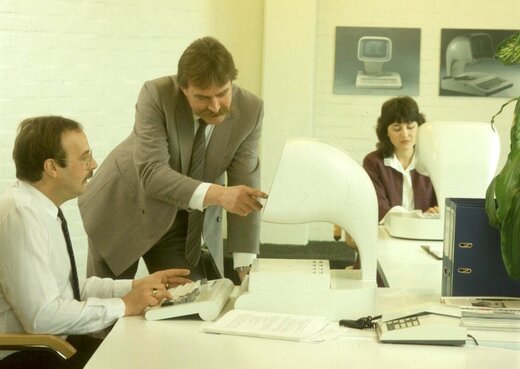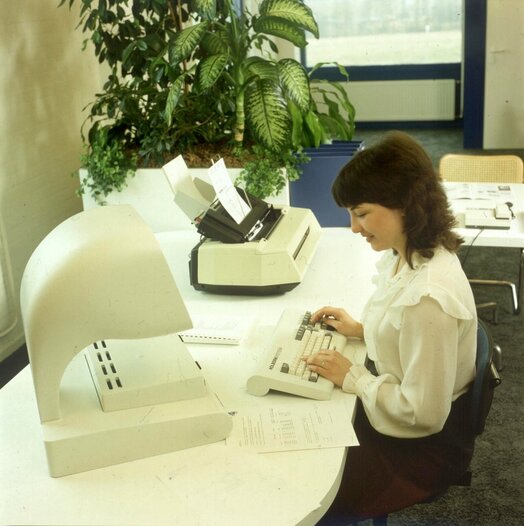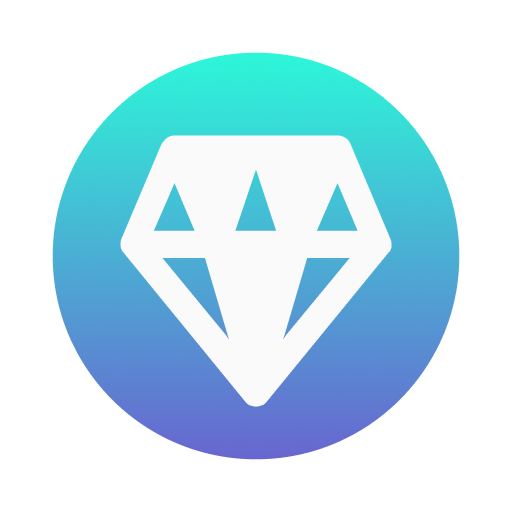Between 1980 and 1983, a little company in The Netherlands built the “Holborn” series of computers… which can best be described as “1950s sci-fi… powered by a Z80”.
Note: The “Holborn” name is to signify that these computers were “Born in Holland”. Hol. Born.
While the company only lasted for a few years — and they only produced a handful of models — their distinctive designs (for both their cases and their hardware & software choices) are worthy of being remembered.
Just to give you a good example… this is the Holborn 9100 (and connected terminals):
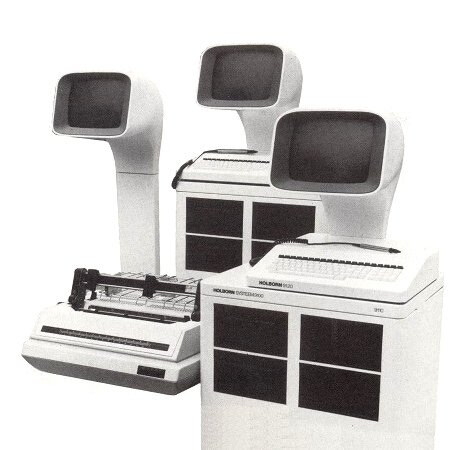
I mean. Wow! Just look at that monitor! That distinctive neck just screams “1950s futurism”… and I absolutely love it.
Ok. Let’s back up a moment.
The company was founded in Hengelo (a town in The Netherlands, near the German border). This is their first office space:
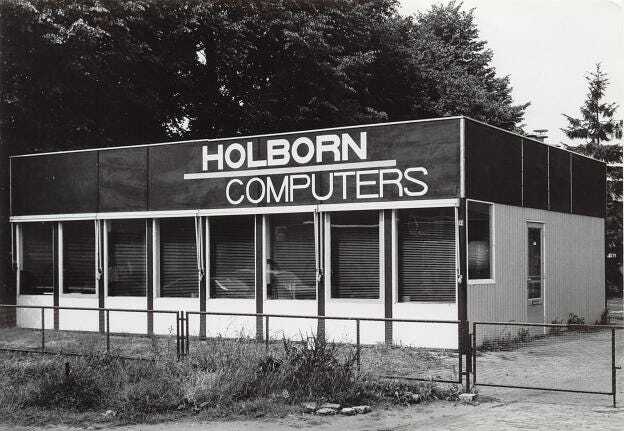
Pictured below are the founders of the company — Dick Gerdzen (left) and Hans Polak (right) — surrounded by a bunch of Holborn computers and terminals.
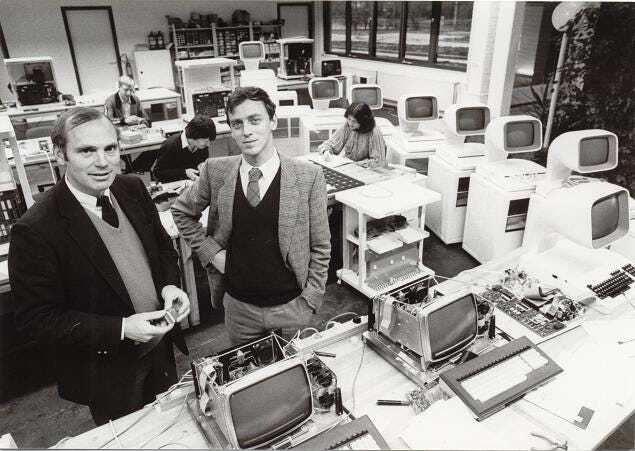
Now. The computers. Let’s tackle them in chronological order.
The Holborn 9100
The first computer from Holborn was the 9100 (and the accompanying 9120 terminal). Pictured on the left in the picture below.

Note that the 9100 computer portion (where the CPU, drives, etc. were contained) is the size of a mini-fridge or a low profile filing cabinet (with the 9120 terminal sitting on top).
Yeah. The big filing cabinet thing on the floor? That’s the primary computer unit.
The specs of this system were as follows:
Zilog Z80 CPU @ 3.5 MHz
72 KB of RAM (expandable to 220 KB)
8 inch floppy drives
Which brings us to the Operating System… it was 100% custom and in-house developed. The Holborn OS was a multi-user system, booted entirely from ROM, which allowed multiple Holborn 9120 terminals to connect to a single Holborn 9100 computer (“Server”).

One extra (and optional) feature of the 9100… it had a photosensitive light pen which could be used as a pointing device. Not a mouse, but a light pen.
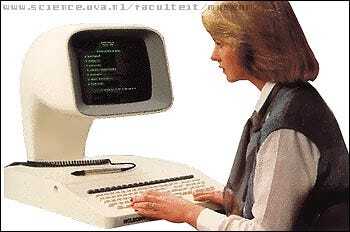
What did the Holborn Operating System look like in practice? How did it work? How, exactly, did the light pen work with the included software?
Those are questions I’ve had for many years… yet, despite hunting high and low, have never found so much as a single picture showcasing the Holborn OS in any readable way. Due to the Holborn OS only being available in ROM on the 9100 itself… no known digital archival copy exists.
In the end, only roughly 200 Holborn 9100 units were sold. (Though that number is debated… more on that in a moment.)
The Holborn 7100
This was a simplified (and cheaper) version of the 9100. Instead of supporting a whole office worth of connected terminals (as with the 9100), the 7100 only supported two connected terminals (users) at once.
It looked like the 9100. Acted like the 9100. Just with… less.
It is unknown how well this model sold. It is assumed that it did not sell well.
The Holborn 6100
In 1982, the Holborn Computer company had to make some tough decisions.
Their Holborn OS (booted from ROM), was not proving popular. And the CP/M operating system (from Gary Kildall’s Digital Research in Pacific Grove, California) was rapidly gaining in popularity.
Luckily the architecture already in use by Holborn computers (the Z80) had a native version of CP/M.
Thus the lower priced, and smaller footprint, Holborn 6100 line was born. Same Z80 CPU, and now with a maximum 192 KB of RAM (slightly less than the 9100)… but, this time, booting the CP/M operating system off disk.
No more booting from ROM. No more in-house developed operating system.
This is the Holborn 6140 with the connected 6110 terminal. See? Much smaller than that gigantic 9100 mini-fridge. But still retained that fantastically interesting terminal design.

Here is a shot of the Holborn 6100’s screen, running CP/M.

How many of these machines shipped? Reports put it somewhere in the ballpark of around 100. Total.
Though the lack of information makes this fact difficult to confirm. Regardless, it was not exactly selling like hotcakes.
The Holborn 6500
The final computer designed by Holborn was the ill-fated 6500.
In the 6500, Holborn removed the keyboard from the terminal body (making it a detached keyboard), and filled the base of the terminal with the computer guts (thus eliminating the need for the separate computer housing used in earlier models). As shown in this advertisement for the “not yet released” 6500:

And here is a shot of the inside of the Holborn 6500, with the top of the case lifted up to show the internals.

Unfortunately Holborn Computers declared bankruptcy in April of 1983… before shipping the 6500.
The End of Holborn
And here is where things become increasingly sad for the company.
When Holborn went bankrupt, investigators determined that only 50 units were sold of the 9100 and 7100 combined. And that the company had over 3.5 million guilders in debt. (Guilders were the currency in use in The Netherlands prior to changing to the Euro. Some quick math tells us that 3.5 Million guilders would be roughly equal to $7 Million USD.)
Would the 6500 model have been enough to save the company? Who knows. Considering the poor sales up till then, and the relatively massive debt (when compared to sales), it seems unlikely.
But one thing is for certain… those are some seriously funky (and awesome) looking machines. So I’m sure glad they tried.
If you ever run across a Holborn, count yourself lucky. These are some of the hardest computers to find nowadays. Considering that only a few hundred were ever sold, you aren’t likely to stumble across them at a flea market or eBay.
With that, I leave you with some pictures of Holborn computers in action. Because they're just so darned cool looking.
